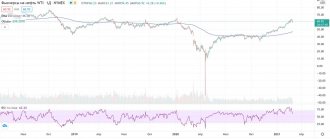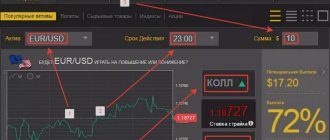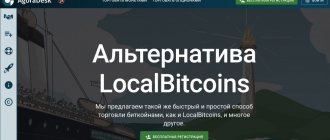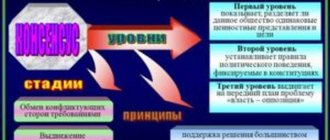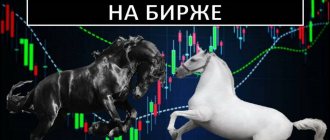Slang names for financial market participants
Let's start with those who are an integral part of any exchange.
Bulls
This is the name given to large traders who, through their actions, try to increase the rate of a financial instrument. For example, Bitcoin recently reached $50,000. Think about it, growing in price from zero to $50,000! Crazy, an ounce of gold costs $1,800.
Who is to blame for this colossal rise? Bulls.
How to remember that a bull is bullish? Imagine him attacking his opponent. How will he beat him? Horns - from bottom to top. The bulls do the same with prices.
The Bears
These are traders who are trying to reduce the price of a financial instrument. For example, in the Russian oil market the bears still have power, so the price still does not start to rise.
How do bears fight? They hit enemies with their paws from top to bottom. Bears do the same with prices - they hit them with their paws, and prices collapse.
I published a separate article about bulls and bears in the market, take a look at it.
If an analyst on TV says that the bears have weakened their positions and the bulls are gaining strength, this means that the downward trend in the market is changing to an upward one. That is, the price fell, fell, fell, and then began to rise.
Sharks
These are also large participants in the financial market who know how to turn it around. These include, first of all, the Central banks of different countries, the US Federal Reserve, and large investment funds. The rates of various financial instruments depend on what decisions they make and what they say.
For example, when the head of the US Federal Reserve begins to make statements on various topics, currency pairs associated with the dollar begin to “jump” from side to side. Or just rise or fall sharply.
The difference between sharks and bulls and bears is that they are not specifically aimed at increasing/decreasing prices. They monitor the general financial situation and determine the directions of financial policy of states or individual economic segments.
Pilot fish
These are the majority of other traders who are trying to analyze the actions of the “sharks” and follow them. For example, I listen to what the head of the Fed says, analyze it, think about how the dollar will react, and open trades to increase or decrease.
If my assumptions are correct and I correctly determined the direction of movement of the “shark”, I will make money. If not, I will lose money.
Pigs
These are stock market players who are blinded by greed. They sooner or later lose all their money because they cannot rationally analyze the market.
Pigs either do not close losing trades on time, hoping that the market will eventually turn around, or they do not dare to close profitable trades, expecting their profits to grow further.
Sheep
Another permanent candidate for departure from the market. These are traders driven by fear. They are afraid to either open a deal on time or close it on time.
Pigs and sheep have one common problem - they do not know how to think rationally and succumb to their emotions.
I once watched a training course from a trader with 15 years of trading experience. He gave the following advice to the pigs and sheep: “Start trading with an amount that you are not afraid of losing. And don’t think of it as a wad of money that gets bigger and smaller. Treat the money in your account like “points” in a game - with absolute indifference. Follow your trading strategy and then analyze the results.”
Give it a try.
Boars
A rarer name. Hogs are traders who overextend their positions. For example, a boar may not close a profitable transaction on time (for various reasons, not only because of greed or fear, like pigs and sheep) and receive a loss on it or “break even.”
Traders become pigs because they lack self-control. They fail to systematically follow their chosen trading strategy.
Kitchens
These are no longer traders, but brokers – organizations that execute traders’ trading orders. Kitchens most often work like this. They register in offshore zones, that is, outside the Russian Federation, lure traders and offer them brokerage services. Traders begin to cooperate with kitchens and open transactions for real money. But kitchens don't bring these deals to the real market. They don't take them anywhere at all.
Kitchen brokers slightly distort stock quotes, as a result of which traders gradually lose all their money. The kitchen withdraws the “merged” deposits where it is legally registered - that is, in an offshore zone. Offshore companies most often are some islands in the Pacific Ocean (Seychelles, Marshall Islands, Grenadines).
To combat the hacks, the Central Bank of the Russian Federation introduced a special license for Forex brokers (there are almost no kitchens on the stock market, there is very strict regulation). In 2015, only 9 brokers out of several hundred that existed received this license, and by 2022 their number had decreased to three. Read more about this in the article about Forex brokers.
Basic investor terms
- An exchange is a place where buyers and sellers can trade securities, commodities, currencies, etc., and an exchange is an organization that provides and regulates the trading process.
There are commodity, currency and cryptocurrency, futures and stock exchanges. They sell and buy, respectively, exchange commodities (precious metals, energy, industrial raw materials, etc.), currencies and cryptocurrencies, futures contracts and securities.
- Closely related to the concept of a stock exchange is the stock market or securities market - the relationship between investors, issuers and their intermediaries associated with the issue and circulation of securities (shares, bonds, futures), which give their owners certain (financial) rights.
- Marketable securities - one of the types of financial instruments - are rights to tangible or intangible assets with a certain value. They represent a real or virtual document - a contract between two parties - as a result of which one of them receives financial assets and the other is subject to financial obligations.
- An asset (underlying asset) is a general name for goods traded on an exchange: securities, raw materials, etc. Assets are also the property of a company or individual, tangible and intangible (for example, a brand) property that has a monetary value and is capable of generating profit. Assets are divided into capital (real estate and equipment), financial and intangible (goodwill). The tangible and intangible assets of a company are called capital.
- On the other side of the scale are always liabilities , i.e. its obligations, for example, debts or loans.
- The value of an asset after deducting all liabilities from it is called equity . This indicator is important for assessing the financial condition of the company and the advisability of investing in it, for example, buying its shares.
Trade on a crypto exchange. Registration
Investments involve the risk of loss of the entire investment. The success of past investments does not mean future success.
- A derivative is a financial contract, as well as an obligation to perform a certain action regarding an underlying asset. The value of a derivative is tied to and based on the price of the underlying asset, but is not necessarily equal.
- There are different types of derivatives, for example, futures - contracts under which the parties undertake to complete a purchase and sale transaction of a certain asset at a predetermined price within a specified period, as well as options - contracts that give the right (not the obligation!) to purchase a certain asset at a specified price. price at a predetermined time.
- One of the most important indicators for any asset is its liquidity , i.e. the ability to quickly and without loss exchange an asset for cash at market value and vice versa.
- Market capitalization is an indicator that allows you to estimate the value of a company, expressed through the value of all shares issued by it. To calculate it, you need to multiply the market price of the shares by their total number. Market capitalization gives traders a way to gauge the size and reliability of a company.
- IPO (Initial Public Offering) is the initial placement of securities or other assets of a company on the stock exchange. Anyone can purchase them and become a shareholder of the company, which as a result changes its status and turns from private to public. In this way, companies attract finance for their development.
- Fiat currencies (FIAT) are national currencies, for example, US dollar, euro, yuan.
- A stock market index (stock market index) is an indicator that represents the aggregate price of shares of its constituent companies, tracks the behavior of shares and allows one to measure their performance. Indexes can track stocks of companies in a specific industry or size. For example, the Dow Jones Industrial Average is calculated based on the share prices of the 30 largest US companies that trade on the New York Stock Exchange, and the FTSE 100 is based on the 100 largest companies on the London Stock Exchange.
The index is calculated as an average or weighted average of the prices of all shares included in it. As a rule, all indexes have an initial number of 1000, which changes depending on the rise or fall in stock prices.
Types of transactions
There are many, but I want to look at the three most common types.
Long
This is what a buy deal is called. As you remember, bulls make money on purchases, that is, on rising prices. What kind of tails do bulls have? Long. Long translated from English means “long”.
Short
These are trades for sale. Bears are trying to make money from sales, that is, from lower prices. What kind of tail do bears have? Quite tiny. Short is translated from English as “short”.
Shorty
This is when a trader trades against the trend and opens short-term trades, trying to make money on corrective pullbacks.
Look, in any market movement there are impulse and corrective waves. An impulse is a strong push in a certain direction, and a correction is a rollback, like a rest for the market. Trying to make money on corrections is very risky, because they are short-lived and can end at any moment. But some traders still open short-term transactions – “short trades” – in order to snag additional profit.
To help you understand better, here is an example of a trend; I will mark the corrections on it in red.
During “red” declines, speculators try to open short trades.
How is it formed and what influences the spread size?
The spread is formed as follows:
- You are submitting a limit order. It ends up in the stock order book and gets in line for execution. If other participants indicated the same price, but did it before you, their orders will be executed first.
- The same thing happens on the opposite side. Hence the two columns in the order book table.
- The difference between the lowest selling price and the highest buying price will be the spread.
- If demand for an asset is high, there will be many people willing to buy or sell it at the market price. This will lead to a decrease in the difference between ask and bid. If demand and trading volumes decline, the gap will widen.
The spread is influenced by the following factors:
Liquidity. The higher the liquidity, the lower the spread. It can change. For example, before the release of important news, participants reduce activity on the stock market or even go into a state of “waiting.” During summer holidays, holidays and after holidays (for example, during the New Year holidays) liquidity may also be low.
Current news and events. Any expected or unexpected news/events may increase or decrease the spread value. The release of financial statements on the state of affairs in the company, information on the development indicators of the industry or the economy as a whole, political events, and natural disasters affect supply and demand in the market, and therefore the difference between bid prices.
Volumes of applications. Let’s imagine that a market order is received to purchase a very large number of securities. It cannot be executed at one price due to its volume. As a result, the broker will partially satisfy the request at one price, partially at another, and so on, in the order of their order in the order book. All this will temporarily increase the gap.
Prices
Let us now consider slang words that are associated with prices on the market.
Hai
This is the highest price that was over a certain period of time. The easiest way to determine it is by the maximum “shadow” of the Japanese candlestick. From English, High (read “high”) is translated as “high.”
For example, here we have a daily chart, each candle on it represents price fluctuations during the day. The high of the candle for February 11 is at the level of 1.21488.
This is the highest price to which the market rose on February 11.
Lowe
Low (read “low”) is translated from English as “low”. This is the minimum price value to which the market fell during a certain time interval.
Looking again at February 11th, the Low would be at 1.21127. Right here.
Open
Open is the first price that was on the market in a certain period of time. For example, on February 11, the first price was 1.21167.
Traders usually don't care much about opening prices. They are more interested in what prices the market closed at.
Close
Close – these are the closing prices. That is, the last prices that were on the market for a specified period of time. On February 11, the close price was 1.21298.
Alexander Elder in his book “How to Play and Win on the Stock Exchange” says that opening prices are set by beginners, and closing prices by professionals. Therefore, traders always closely monitor Closes and use the word “Close” much more often than “Open”.
Rebound
This is when the price approached a certain level and sharply turned around from it - “bounced”. To see a rebound, you must first find support and resistance levels on the chart. For example, like here.
There are also rebounds from “psychological” levels. For example, when prices reach some round values. If the euro rises to 100 rubles, this will be just a “psychological” level. And the price will either rebound from it, or, conversely, make a powerful breakout and go up sharply.
Breakdown
The opposite situation. In the event of a breakdown, the price does not bounce off the level, but “breaks through” it. Most often, in such cases, the resistance level turns into a support level (and vice versa) and the price begins to “rely on it in its movement.
For example, here I highlight breakouts with blue rectangles, and situations when the market uses the broken level as support or resistance with red rectangles.
In our case, we get a very consistent picture. Support – breakdown – resistance – breakdown – support – breakdown – resistance.
Traders sometimes call strong breakouts the word “takeout.” That is, the price has “carried out” beyond a certain level.
A
A share is a type of security that assigns to its owner (shareholder) the right to a part of the JSC’s profit, to participate in the board of directors and to a part of the property equivalent to a block of shares in the event of the closure of the JSC.
Do you know the difference between an ordinary share and a preferred share?
Algorithmic trading is a method of working with the market that involves the use of algorithms - automatic or semi-automatic robot programs.
Algotrader is a market participant who works using algorithms.
Analysis is the process of studying various indicators in order to forecast future price fluctuations. There are technical (using indicators) and fundamental (taking into account macroeconomic indicators of the economies of different countries) types of analysis.
Ask (from the English Ask) is the cost of a product at which the seller is ready to sell it.
Time periods in which traders trade
Typically, time intervals for trading are called without slang expressions, for example: “five-minute chart”, “four-hour chart”. But there are also a couple of slang words.
Day
This is what is called the daily chart. That is, one in which each candle reflects price fluctuations for one day.
This word can be found very often. The reason for this is the attitude of traders to “noise” in the market. Most traders believe that all charts before the daily one convey market “noise” and it is impossible to normally analyze the economic situation using them. During the day, noise is minimal, making it ideal for analytics.
There is even less noise on the “weekly” timeframe, but only those traders who invest colossal sums in the market can wait for a profit for weeks.
Introday
This is what is “inside the day.” In theory, intraday trading includes all timeframes that are smaller than the daily one, but usually introday trading is speculation on hourly or four-hour charts. That is, right here.
If the designations are not familiar to you, let me explain:
- M – minute. M1 is a chart, each candle on which shows price fluctuations within a minute, M30 – within thirty minutes.
- H – hour. From English "Hour" (hour). H1 – 1 hour, H4 – 4 hours.
- D – day. From the English “Day” (day).
- W – week. From Week.
- MN – month. From "Month".
Long term
This is when traders hold positions open for several days or weeks. This happens most often like this. A trader opens a position, the price moves sharply in the desired direction, the trader closes part of the transaction, and puts a “break-even” on the rest. That is, if the price reverses, the transaction will be closed at the opening price and the speculator will not lose anything.
Traders sometimes leave such transactions even for months. But “breakeven” does not mean that the deal will never go into the red. This can happen if the Stop Loss does not work - for example, due to a gap.
Dictionary of cryptocurrencies
- Cryptocurrency is virtual (digital) money, the issue and circulation of which occurs in electronic form. They have no physical expression and, unlike world currencies, are not controlled by the state. All accounting of cryptocurrency and transactions carried out with it is maintained by a decentralized payment system that operates offline. Cryptocurrency transactions are usually irreversible (there is no way to block or cancel the transaction). There are various cryptocurrencies, among the most famous are Bitcoin, Ethereum, Monero, Litecoin.
- Bitcoin allows you to freely make payments from user to user without an intermediary and commissions 24/7, but at the same time this cryptocurrency is very volatile and subject to price fluctuations. The total supply of Bitcoins is limited to 21 million coins. Existing bitcoins can be purchased on crypto exchanges, and new ones are generated through the mining process.
- Mining is the process of conducting and verifying transactions that allows you to generate new coins. In practice, this means that miners solve complex mathematical problems, their results are verified by the system and a reward is issued in the form of coins (Proof of Work (PoW) approach). Depending on the type of cryptocurrency, the mining process can be very energy- and labor-intensive and require special equipment, as is the case with Bitcoin.
- Blockchain is a database that is used to make cryptocurrency payments without intermediaries. Each transaction is included in a block, verified by the network and linked to the previous block. The process is controlled by the entire blockchain network, which helps protect transaction records from unauthorized changes.
- A stablecoin is a cryptocurrency that is tied in value to another asset: currency, precious metals, or another cryptocurrency. This ensures greater price stability. A stablecoin must be backed by a reserve supply of a corresponding asset, such as a foreign exchange account or precious metals in a vault.
- A token is a cryptocurrency that allows access to: a specific asset (for example, tokenized securities or a coin that denotes ownership of a certain amount of precious metals), a product (payment tokens), a service (utility tokens).
Tokens can be bought and sold on a cryptocurrency exchange, exchanged for other cryptocurrencies, and also converted into fiat, and a special compound contract allows you to borrow and lend tokens and earn interest on it.
- Sometimes you can get tokens for free if certain conditions are met. For example, if you own other cryptocurrencies.
- This distribution is called an airdrop and is often carried out to attract attention to a project. It can also be the beginning of an ICO - an initial placement of tokens to raise funds for the development of a company or project.
Trading process
Let us now examine the expressions that traders use directly in trading.
Catch a moose
This means closing a trade using Stop Loss. The word “elk” is consonant with the word “Loss” (from the English “Loss” - loss). Stop losses are placed by traders in order to sell financial instruments that have become unprofitable. That is, they lose a certain amount of money, but do not lose the entire deposit.
Catching moose is not a pleasant experience. Making a profit is another matter.
Make a profit
This expression has two meanings. The first is to simply close the trading position with a profit. Profit is just profit (from the English “Profit”). The second is to close the deal using Take Profit.
Take Profit is a trading order, the opposite of Stop Loss. The trader opens a deal, assumes approximately what level the price will go to, and sets a Take Profit at this level. When the price reaches the level, the broker automatically closes the deal and the trader makes a profit.
Fix
Another option is to “cover.” This means closing deals. The word “fix” is more often used in relation to transactions that are closed with a profit. Because the trader “fixes” profit in this way. And if the deal is unprofitable, then, in theory, there is nothing to “fix.”
Covering is a broader concept. A trader may decide to "cover" for various reasons. For example, some important news is planned to be released, the speculator does not want to take risks and be nervous, so he closes all trading positions - both profitable and unprofitable.
Play against the market
This is what traders do who try to make money on corrective pullbacks within a trend. I already mentioned this strategy above when I talked about the word “rollback”. And he also spoke about its dangers.
pip
That is, trying to make money on small price fluctuations. “Piping” has a more popular name – scalping.
Scalpers open hundreds of trades throughout the day. As soon as even a tiny profit appears, they quickly “hide” and “fix” this profit. By gaining “a few pips” from each trade, scalpers can make very large profits.
But this style of trading is terribly nervous, stressful and exhausting.
Margin
This means conducting margin trading – speculating in the market with leverage. I had a separate article about leverage, you should definitely read it so as not to lose all your money at once in the first trade.
On the one hand, leverage allows you to get high profits by investing very small amounts of money. On the other hand, because of it you can quickly lose your entire deposit and even remain in debt to the broker.
marinate
Rare term. It is used when a trader buys some kind of financial instrument to make money on changes in its exchange rate, and then does not sell it for a long, long time - “marinates”.
Sometimes pickling brings in a lot of money. And sometimes traders who are addicted to it turn into “hogs” - those who lost money because they kept positions open for too long.
D
Derivative (from the English Derivative) is a class of assets, which include forwards, options and futures.
Do you know the difference between futures and options?
A decentralized market is a market in which transactions are conducted on several trading platforms.
Dealer (from the English Dealer) is a counterparty in a transaction.
Dealing center (also DC) is the place of work of dealers. In traders' jargon it is often called the kitchen.
Discretionary analysis is a method of studying value using logic, without the use of standard methods of analysis.
A day trader is an exchange player who opens and closes all transactions within a day, i.e. within 24 hours (or less).
Diversification is the distribution of investment funds in order to reduce risk and loss of income.
Useful materials on the topic
If you are interested in trading, check out my article with a selection of trading courses. I compiled it myself, the selection begins with free materials. Moreover, the materials, although free, are very high quality and in-depth.
If you are too lazy to read the selection, watch this first lesson of the basic trading course. There are five of them in total, taught by professional trader Eduard Sungatullin. The material is aimed at the Forex currency market, but there are a lot of topics that relate to trading in general, technical analysis, and financial calculations. I recommend watching it with a notepad and pen.
When I started learning trading five years ago, I believed that you could make real money playing the stock market. Now I don’t think so and try to convince readers not to risk their money in speculation.
If you have money, it’s better to engage in passive investing. Passive investing is when you don't try to guess how the price of, say, a stock will change. It doesn't matter to you at all. You buy a share and receive stable dividends from it.
If this topic is interesting to you, I can recommend the course “Personal Finance and Investments from Netology.” I watched it myself, however, back when the course was not so extensive, there was an order of magnitude less information in it. The teacher is professional investor Sergei Spirin, he explains everything simply and clearly, and provides a lot of supporting literature.
I also highly recommend these three books on investing. They are free and electronic. Download now and start reading.
- How to become financially independent in 1 year.
- 5 ways to effectively invest 1000+ rubles.
- 6 steps to financial security.
The authors of the books are the leaders of the City of Investors project. Both I and Vasily Blinov, who created this site, constantly monitor the development of their resource. The content is simply great, especially for beginners.
If you want to continue learning about finance and investing, subscribe to my newsletter. A lot of new articles on financial topics will be published in the next six months, I think you will be interested. Plus, everything is free.
Overshoot and overflow
Let's look at two more specific trading terms that beginners may encounter on websites, forums and when watching educational videos.
Overshoot is a situation in which the quotes of an investment asset show a new maximum, located above the previous one.
Overlow (breaking point) is a situation in which the quotes of an investment asset show a new minimum, located below the previous one.
The promissory note system - blood oaths
John helped his daughter Sophia escape, and in return received a promissory note - a blood oath. These bills are made of intricate gold designs and open like a locket. Inside there is space for two fingerprints - one put by the one who takes the oath, and the other by the holder of the bill, who confirms that his debtor has provided the service to the holder for which he asked.
Medallion bill from the movie John Wick
Regardless of the relationship between the parties, the debt of the bill is non-negotiable . If someone has your promissory note, you owe them, period.
Place of the BKEX exchange in the ranking of crypto exchanges in the world
The BKEX exchange ranks 35th in the popularity ranking for queries in the Yandex search engine. The number of requests is 1,179 per month.
| Place | Name | Requests in Yandex per month | Trading volume in $ billion per 24 hours as of 06/09/21 | Fiat currency support |
| 1 | Binance | 632390 | 30 | AED, ARS, AUD + 43 more |
| 2 | Liquid | 135104 | 0,27 | USD, JPY, EUR + 3 more |
| 3 | Coinbase Exchange | 56464 | 4,23 | USD, GBR, EUR |
| 4 | Kraken | 50008 | 1,93 | USD, EUR, GBP + 4 more |
| 5 | Gemini | 46359 | 0,31 | USD |
| 6 | EXMO | 40879 | 0,076 | USD, RUB, EUR |
| 7 | OKEx | 25729 | 6,74 | No |
| 8 | Gate.io | 20494 | 0,89 | KRW, EUR |
| 9 | Huobi Global | 16377 | 8,24 | ALL, AUD, BRL + 47 more |
| 10 | Crypto.com Exchange | 16282 | 0,23 | No |
| 11 | Poloniex | 15701 | 0,23 | No |
| 12 | Hotbit | 13093 | 0,22 | No |
| 13 | Currency.com | 10696 | 0,096 | RUB, USD + 2 more |
| 14 | Blockchain.com | 8063 | 0,039 | USD, EUR + 2 more |
| 15 | KuCoin | 7111 | 1,55 | No |
| 16 | Bittrex | 7106 | 0,18 | USD |
| 17 | 50x | 6928 | <0,001 | No |
| 18 | HitBTC | 5687 | 3,55 | No |
| 19 | Bitfinex | 5162 | 1,72 | USD, EUR + 2 more |
| 20 | Coinsbit | 4828 | 2,75 | EUR, USD |
| 21 | Hoo | 4740 | 0,57 | No |
| 22 | CoinEx | 4512 | 0,12 | No |
| 23 | AAX | 4485 | 0,085 | No |
| 24 | Mercado Bitcoin | 3909 | 0,015 | BRL |
| 25 | XT.COM | 2563 | 3,69 | AUD, GBR, USD + 4 more |
| 26 | Bithumb | 2469 | 1,32 | KRW |
| 27 | Bithumb Global | 2469 | 0,17 | RUB, TRY |
| 28 | CEX.IO | 2208 | 0,088 | USD, EUR, GBR |
| 29 | LATOKEN | 2192 | 0,4 | No |
| 30 | WazirX | 2129 | 0,091 | INR |
| 31 | ProBit Exchange | 1800 | 0,29 | KRW |
| 32 | Luno | 1731 | 0,05 | EUR, AUD + 8 more |
| 33 | MXC.COM | 1412 | 0,19 | No |
| 34 | Bitstamp | 1361 | 0,84 | USD, EUR, GBR |
| 35 | BKEX | 1179 | 1,51 | No |
| 36 | Coinlist Pro | 1043 | 0,01 | USD |
| 37 | WhiteBIT | 875 | 0,56 | No |
| 38 | BtcTurk | Pro | 828 | 0,22 | TRY |
| 39 | BigONE | 766 | 0,81 | No |
| 40 | Bitrue | 693 | 0,027 | No |
| 41 | AscendEX (Bitmax) | 532 | 0,15 | No |
| 42 | Paribu | 474 | 0,25 | TRY |
| 43 | Indodax | 473 | 0,084 | IDR |
| 44 | DigiFinex | 451 | 2,4 | No |
| 45 | LBank | 416 | 2,69 | No |
| 46 | Okcoin | 391 | 0,084 | USD, EUR |
| 47 | Upbit | 387 | 7,44 | KRW |
| 48 | Coincheck | 363 | 0,22 | JPY |
| 49 | BTC Markets | 352 | 0,013 | AUD |
| 50 | CoinBene | 332 | 1,02 | No |
| 51 | EQUOS | 323 | 0,18 | No |
| 52 | Coinbit | 311 | 0,5 | KRW |
| 53 | ZB.COM | 293 | 2,04 | No |
| 54 | Finexbox | 281 | 0,21 | No |
| 55 | Bitpanda Pro | 280 | 0,032 | CHF + 3 more |
| 56 | Zaif | 268 | 0,13 | JPY |
| 57 | Binance.US | 263 | 1,18 | USD |
| 58 | Cryptology | 257 | 0,013 | USD, EUR |
| 59 | KickEX | 225 | 0,038 | No |
| 60 | ExMarkets | 151 | 0,39 | EUR |
| 61 | CoinDCX | 116 | 0,064 | INR |
| 62 | Coinone | 109 | 0,58 | KRW |
| 63 | Dex-Trade | 107 | 0,081 | No |
| 64 | Korbit | 97 | 0,051 | KRW |
| 65 | MAX Exchange | 92 | 0,016 | TWD |
| 66 | Bitbns | 89 | 0,028 | INR |
| 67 | bitFlyer | 88 | 0,42 | EUR, USD, JPY |
| 68 | Coinfloor | 83 | 0,008 | EUR, GBR |
| 69 | GOPAX | 75 | 0,066 | KRW |
| 70 | IndoEx | 74 | 1,51 | No |
| 71 | BitWell | 72 | 0,54 | No |
| 72 | Bitso | 71 | 0,02 | MXN, ARS |
| 73 | Bitkub | 59 | 0,097 | THB |
| 74 | Paritex | 59 | 0,13 | TRY |
| 75 | Bitexen | 55 | 0,15 | No |
| 76 | Felixo | 53 | 0,027 | No |
| 77 | eToroX | 51 | 0,032 | USD |
| 78 | itBit | 50 | n.d. USD | |
| 79 | Bitvavo | 45 | 0,22 | EUR |
| 80 | Bitbank | 44 | 0,17 | JPY |
| 81 | Coindeal | 40 | 0,033 | No |
| 82 | CoinZoom | 26 | 0,003 | No |
| 83 | Alterdice | 19 | 0,081 | No |
| 84 | Zipmex | 18 | 0,023 | THB, SGD |
| 85 | Huobi Korea | 17 | 0,081 | KRW |
| 86 | Bitay | 15 | 0,41 | No |
| 87 | CoinFLEX | 14 | 0,028 | No |
| 88 | ZebPay | 13 | 0,024 | AUD, INR, SGD |
| 89 | FOBLGATE | 12 | 0,14 | KRW |
| 90 | Independent Reserve | 12 | 0,011 | USD, AUD, NZD |
| 91 | GokuMarket | 8 | 0,29 | EUR |
| 92 | Coinzo | 8 | 0,037 | TRY |
| 93 | NovaDAX | 7 | 0,006 | BRL, EUR |
| 94 | B2BX | 6 | 0,048 | USD, EUR, GBP |
| 95 | Folgory | 6 | 0,29 | No |
| 96 | Hanbitco | 5 | 0,015 | No |
| 97 | CrossTower | 6 | 0,003 | No |
| 98 | Rekeningku.com | 3 | 0,016 | IDR |
| 99 | Huobi Indonesia | 2 | <0,001 | IDR |
| 100 | Bitfront | 1 | 0,93 | USD |
In the Coinmarket ranking, the BKEX crypto exchange ranks low at 240th place.
BKEX exchange statistics.
John Wick's activities at the beginning of his killer career
Before he married, Wick was such an experienced and successful killer that he quickly earned the nickname “Baba Yaga” because he was so deadly that he terrified even other killers.
After leaving Ruska Roma, John joined a gang led by one of the main security forces, Viggo Tarasov. During this time, John developed various relationships with people at different levels of the Clan Board - the ruling body of the underworld, with delegates from each of the 12 families. They control criminal activities around the world.
John developed friendly relations with several allies, including the staff of the Continental Hotel, especially the friendly hotel manager, Winston.
Hotel Manager Continental Winston
Unfortunately, he also developed a collection of frenemies among his colleagues and competitors, which is inevitable in a game with such stakes.
At some point during the Assassin era, John crossed paths with Sophia, another dog lover and Assassin, who became the manager of the Continental branch in Casablanca.

